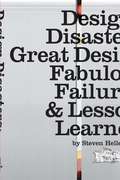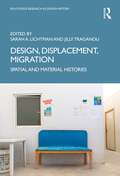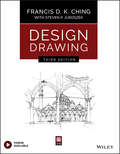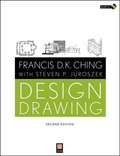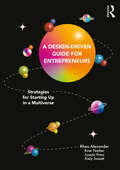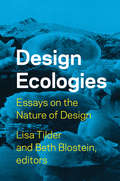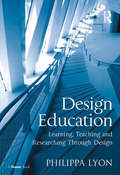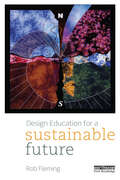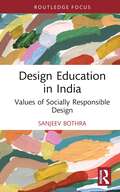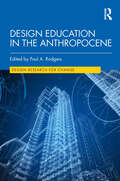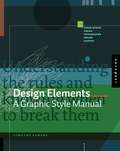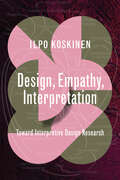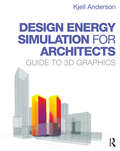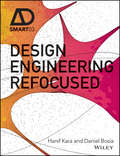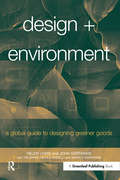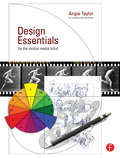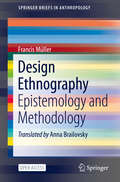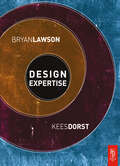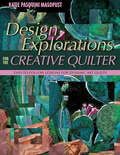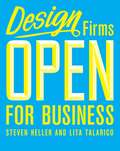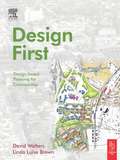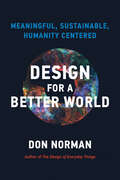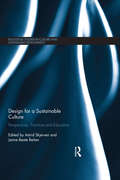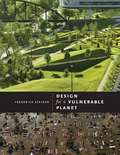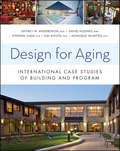- Table View
- List View
Design Disasters: Great Designers, Fabulous Failure, and Lessons Learned
by Steven HellerThe thrill of victory...the agony of defeat. We're not talking about just any failure. Design failure. So public. So humiliating. How do designers who are really, really good (we swear!) turn a disaster into a triumph? Read this book and find out, as dozens of top names reveal the heartbreaking-and sometimes hilarious-mistakes they have made and talk about how they were able to grow from the experiences. Self-delusion, overcommitment, procrastination...they're all here. Poor communication, missed deadlines, enraged clients...yes, they're here too. Read Design Disasters and weep? No! Read Design Disasters and be inspired to find the silver lining in even the cloudiest situation.Featuring essays by: Henry Petroski Alissa Walker David Barringer Allan Chocinov Peter Blegvad Ross MacDonald Robert Grossman Ina Saltz Warren Lehrer Rob Trostle Ralph Caplan Richard Saul Wurman Marian Bantjes Rick Meyerowitz Amanda Bowers David Jury Veronique Vienne Francis Levy Colin Berry Nick Curry Debbie Millman, and more!
Design, Displacement, Migration: Spatial and Material Histories (Routledge Research in Design History)
by Sarah A. LichtmanDesign, Displacement, Migration: Spatial and Material Histories gathers a collection of scholarly and creative voices—spanning design, art, and architectural history; design studies; curation; poetry; activism; and social sciences––to interrogate the intersections of design and displacement. The contributors foreground objects, spaces, visual, and material practices and consider design’s role in the empire, the state, and various colonizing regimes in controlling the mass movement of people, things, and ideas across borders, as well as in social acts that resist forced mobility and immobility, or enact new possibilities. By consciously surfacing echoes, rhymes, and dissonances among varied histories, this volume highlights local specificity while also accounting for the vectors of displacement and design across borders and histories. Design, Displacement, Migration: Spatial and Material Histories shows displacement to be a lens for understanding space and materiality and vice versa, particularly within the context of modernity and colonialism. This book will be of interest to scholars working in design history, design studies, architectural history, art history, urban studies, and migration studies.
Design Drawing (Architecture Ser.)
by Francis D. ChingTHE CLASSIC GUIDE TO DRAWING FOR DESIGNERS, REVISED AND UPDATED TO INCLUDE CURRENT DIGITAL-DRAWING TECHNIQUES Hand drawing is an integral part of the design process and central to the architecture profession. An architect's precise interpretation and freedom of expression are captured through hand drawing, and it is perhaps the most fundamental skill that the designer must develop in order to communicate thoughts and ideas effectively. In his distinctive style, world-renowned author Francis D. K. Ching presents Design Drawing, Third Edition, the classic guide to hand drawing that clearly demonstrates how to use drawing as a practical tool for formulating and working through design problems. While digital tools continue to evolve, this Third Edition includes new illustrations and information on the latest digital-drawing techniques. Design Drawing, Third Edition covers the basics of drawing, including line, shape, tone, and space. Guiding the reader step-by-step through the entire drawing process, this Third Edition also examines different types of drawing techniques such as multiview, paraline, and perspective drawings—and reveals how the application of these techniques creates remarkable results. In addition, Design Drawing, Third Edition: • Features over 1,500 hand drawings—stunning illustrations in the author's signature style that reinforce the concepts and lessons of each chapter • Offers new exercises and illustrative examples that range in complexity • Presents all-new digital drawing topics, such as hybrid floor plans, digital models and fabrication, and hand-to-digital fluency • Includes access to a new website featuring videos of the author demonstrating freehand techniques in a step-by-step manner in the studio and on location Written and illustrated for professional architects, designers, fine artists, illustrators, instructors and students, Design Drawing, Third Edition is an all-in-one package and effective tool that clearly demonstrates drawing concepts and techniques in a visually stimulating format that outshines other works in the field.
Design Drawing
by Francis D. Ching Steven P. JuroszekGet the completely revised edition to mastering the visual language of architecture.In his distinctive graphic style, world-renowned author and architecture educator Francis D.K. Ching takes us on another exciting journey through the process of creation. In Design Drawing, Second Edition, he unmasks the basic cognitive processes that drive visual perception and expression, incorporating observation, memory, and rendering into a creative whole. This edition unites imaginative vision with fundamental architectural principles to cover the traditional basics of drawing, including line, shape, tone, and space. Guiding the reader step-by-step through the entire drawing process, Design Drawing also examines different types of drawing techniques such as multiview, paraline, and perspective drawings -- and how they can be applied to achieve stunning results. In addition, this edition:Goes beyond basic drawing books--Ching not only covers the principles, media, and techniques of drawing, but also places these within the context of what and why designers draw.Features more than 1,500 hand-rendered drawings--beautiful illustrations that reinforce the concepts and lessons of each chapter.Includes a supplemental CD-ROM--viewers will gain a greater appreciation of the techniques presented in this book through the power of animation, video, and 3D models. Twelve new modules are included, as is a video of the author demonstrating freehand techniques in a step-by-step manner.For professional architects, designers, fine artists, illustrators, teachers and students alike, this all-in-one package is both an effective tool and an outstanding value, demonstrating concepts and techniques in a visually stimulating format that transends comparable works in the field.
A Design Driven Guide for Entrepreneurs: Strategies for Starting up in a Multiverse
by Rhea Alexander Rose Pember Joseph Press Kiely SweattA new wave of entrepreneurs is leading a global paradigm shift towards values-driven business. This book empowers you to challenge the status quo and create value through its unique and adaptive approach to venture-building by design. Authored by a multidisciplinary team of practicing design strategists, business leaders, academics, and entrepreneurs, this hands-on guide models strategic design as a mindset for starting up: framing problems, applying methods, identifying opportunities, and creating pathways forward through futures and systems thinking. Carefully curated case studies of young impact-driven entrepreneurs along with resources, including action-based frameworks, diagrams, and templates for founders to replicate, and a reader’s checklist to enable the transformation of daily practice, will open new dimensions that amplify the global shift towards a more regenerative world and a multiverse of possibilities. Are you ready to journey to places where ideas for products, services, and experiences transform how we live and work? Then this guide is for you: the Design-Driven Entrepreneur.
Design Ecologies: Essays on the Nature of Design
by Lisa Tilder Beth BlotsteinContemporary architects are under increasing pressure to offer a sustainable future. But with all the focus on green building there has been little investigation into the meaningful connections between architectural design, ecological systems, and environmentalism. A new generation of architects, landscape architects, designers, and engineers aims to recalibrate what humans do in the world according to how the world works as a biophysical system. Design in this sense is a larger concept having to do as much with politics and ethics as with aesthetics and technology. This recasting of the green movement for the twenty-first century transforms design into a positive agent balancing societal values with environmental needs.Design Ecologies is a ground-breaking collection of never-before-published essays and case studies by today's most innovative designers and critics. Their design strategies—social, material, and biological—run the gamut from the intuitive to the highly technological. One essay likens window-unit air conditioners in New York City to weeds in order to spearhead the development of potential design solutions. Latz + Partner's Landscape Park integrates vegetation and industry in an urban park built amongst the monumental ruins of a former steelworks in Duisburg Nord, Germany. The engineering firm Arup presents its thirty-three-square-mile masterplan for Dongtan Eco City, an energy-independent city that China hopes will house half a million people by 2050. An essay by designer Bruce Mau leads off a stellar list of emerging designers, including Jane Amidon, Blaine Brownell, David Gissen, Gross.Max, Robert Sumrell and Kazys Varnelis, Stephen Kieran and James Timberlake, R&Sie(n), Studio 804, and WORKac.
Design Education: Learning, Teaching and Researching Through Design
by Philippa LyonEmbracing the richness, complexity and possibilities of learning and teaching in design, Design Education takes the vantage point of the 'outsider' and explores what makes design so compulsively fascinating for those who teach and study it. Through more than 40 projects, from design students' use of archives and museum collections to the potential of specific technologies to enhance teaching and learning, from architecture and 3D design to fashion, Philippa Lyon explores aspects of learning and teaching in higher education design subjects. Taking an ethnographic approach and using data from interviews, discussions and observations, the book also examines issues such as the experience of design teacher-practitioners entering the world of learning and teaching research for the first time. Design Education encapsulates and analyzes the research findings facilitated by the UK-based Centre for Excellence in Teaching and Learning Through Design. It delves into many pedagogical terms and assumptions and guides the reader through them, examining the way relevant key concepts in design are articulated. It will be useful to teachers and students of design subjects, learning and interpretation staff in museums, pedagogical researchers, other centres for excellence in teaching and learning (particularly those which are art and design-related), independent design practitioners and managers of art and design provision in the public and private sector.
Design Education for a Sustainable Future
by Rob FlemingSustainability is a powerful force that is fundamentally reshaping humanity’s relationship to the natural world and is ushering in the Age of Integration. The move from well-intentioned environmental friendliness to the higher bar of integral sustainability and regenerative design demands a new type of design professional, one that is deeply collaborative, ethically grounded, empathically connected and technologically empowered. As a response, this book argues for a great leap forward in design education: from an individualistic and competitive model casually focused on greening; to a new approach defined by an integral consciousness, shaped by the values of inclusivity and cooperation, and implemented by a series of integrative behaviors including: an ethically infused design brief a co-creative design process on-going value engineering pre-emptive engineering design validation through simulation on-line enabled integrated learning the use of well vetted rating systems. This book contains the integral frameworks, whole system change methodologies and intrinsic values that will assist professors and their students in an authentic and effective pursuit of design education for a sustainable future.
Design Education in India: Values of Socially Responsible Design (Routledge Research in Social Design)
by Sanjeev BothraThis book traces developments in design education in India and shows the continuing impact of the Bauhaus School of design education, which formed the basis of the National Institute of Design. It presents the findings of the author's research and experiential learning as a design educator over a 25-year period. This book argues that as the effects of climate change and the exploitation of natural and human resources become more pervasive, it has become increasingly important to ensure that the values of social responsibility are instilled into the design students who will become future practitioners. This book offers an alternative model of understanding regarding the ecosystem of design and sustainable design education. Going beyond description and analysis, it includes three case studies of adoptable design curricula created by the author, with student responses to the programmes to provide first-hand insights into their impact. Research findings are based on detailed interviews with contemporary faculty members, all experts in the various design disciplines, along with an in-depth survey of existing design programmes in India. Design Education in India encourages a paradigm shift in thinking about the environment, spaces and places. It offers a unique perspective on the status of design education in an important and fast-growing economy and will be a useful read for design educators and researchers in varied disciplines.
Design Education in the Anthropocene (Design Research for Change)
by Paul A. RodgersThis volume examines emerging practice and research in design education rooted in the context of significant global issues.A diverse set of international contributors present novel design education research that seeks to make significant social, economic, cultural and environmental change. Topics covered include fashion, sustainability, creativity, social justice, museum education, climate change, environmentalism, and empathy. The chapters draw a link between current research practice and theory and future challenges for the field.The book will be of interest to scholars working in communication design, graphic design, design research, and information design.
Design Elements: Understanding the Rules and Knowing When to Break Them
by Timothy SamaraThis book is a compact and lucid handbook outlining the basic principles of layout, typography, color usage and space.
Design, Empathy, Interpretation: Toward Interpretive Design Research (Design Thinking, Design Theory)
by Ilpo KoskinenA new, empathic approach to design research, drawn from the informed experiences of a leading design research program in Finland.Design, Empathy, Interpretation tells the story of empathic design, a design research program at Aalto University in Helsinki, Finland, that has developed an interpretive approach to design over the past twenty years. As one of the leaders of the Helsinki group, Ilpo Koskinen draws on his own experiences to offer readers a general intellectual and professional history of design research, and argues for what he calls an interpretive approach. Design, Empathy, Interpretation shows how the group has created connections all across the globe, and how a seemingly soft approach to design research can be useful in both industry and government.Koskinen follows design research&’s transformation from questions of usability, in the 1980s, through to the revolution in personal electronics and the &“user-centered&” turn of the 1990s. Using the research community in Helsinki as a case study, and moving between specific projects and theoretical debates, he offers readers a focused introduction to the major methodological and intellectual challenges—as well as the opportunities—of design research. He argues that all design tasks, however simple or complex, begin with understanding the way humans ascribe meaning, both as individuals and as actors in complex societies. Thus all design research must be interpretive at its core.A new, empathic approach to design research, drawn from the informed experiences of a leading design research program in Finland.
Design Energy Simulation for Architects: Guide to 3D Graphics
by Kjell AndersonLeading architectural firms are now using in-house design simulation to help make more sustainable design decisions. Taking advantage of these new tools requires understanding of what can be done with simulation, how to do it, and how to interpret the results. This software-agnostic book, which is intended for you to use as a professional architect, shows you how to reduce the energy use of all buildings using simulation for shading, daylighting, airflow, and energy modeling. Written by a practicing architect who specializes in design simulation, the book includes 30 case studies of net-zero buildings, as well as of projects with less lofty goals, to demonstrate how energy simulation has helped designers make early decisions. Within each case study, author Kjell Anderson mentions the software used, how the simulation was set up, and how the project team used the simulation to make design decisions. Chapters and case studies are written so that you learn general concepts without being tied to particular software. Each chapter builds on the theory from previous chapters, includes a summary of concept-level hand calculations (if applicable), and gives comprehensive explanations with graphic examples. Additional topics include simulation basics, comfort, climate analysis, a discussion on how simulation is integrated into some firms, and an overview of some popular design simulation software.
Design Engineering Refocused (AD Smart)
by Hanif Kara Daniel BosiaThe contents of the book will highlight the differences between the design and engineering disciplines – strengths and flaws. It will also illustrate examples of interdisciplinary interactions. Any false dichotomies will be revealed and the many non-linear processes borne out of challenging conventions between traditional and new modes of practice will be revealed. Projects based on a body of experience spanning many years will be selected to support experimentation that goes beyond an undisciplined search for originality, innovation and creativity. In addition to writings from Hanif Kara and Daniel Bosia contributions will be sought from specialists in the field who have played a role in the operations of P.art® at AKT II – past and present – qualifying them to disseminate and distribute a particular form of ‘knowledge’. Features work of architectural practices: Adjaye Associates, Foster + Partners, Heatherwick Studio, HOK, Serie Architects, Wilkinson Eyre Architects and Zaha Hadid Architects. In addition to AKT II, it will encompass the work of engineers and engineering consultants such as: Arup, Cecil Balmond, Buckminster Fuller, Buro Happold, Pier Luigi Nervi and Peter Rice.
Design + Environment: A Global Guide to Designing Greener Goods
by Helen Lewis John Gertsakis Tim Grant Nicola Morelli Andrew SweatmanThere is a huge scarcity of good, practical resources for designers and students interested in minimizing the environmental impacts of products. Design + Environment has been specifically written to address this paucity. The book first provides background information to help the reader understand how and why design for environment (DfE) has become so critical to design, with reference to some of the most influential writers, designers and companies in the field. Next, Design + Environment provides a step-by-step approach on how to approach DfE: to design a product that meets requirements for quality, cost, manufacturability and consumer appeal, while at the same time minimising environmental impacts. The first step in the process is to undertake an assessment of environmental impacts, using life-cycle assessment (LCA) or one of the many simpler tools available to help the designer. From then on, DfE becomes an integral part of the normal design process, including the development of concepts, design of prototypes, final design and development of marketing strategies. Environmental assessment tools and strategies to reduce environmental impacts, such as the selection of appropriate materials, are then discussed. Next, some of the links between environmental problems, such as global warming, ozone depletion, water and air pollution and the everyday products we consume are considered. In order to design products with minimal environmental impact, we need to have a basic understanding of these impacts and the interactions between them. The four subsequent chapters provide more detailed strategies and case studies for particular product groups: packaging, textiles, furniture, and electrical and electronic products. Guidelines are provided for each of the critical stages of a product's life, from the selection of raw materials through to strategies for recovery and recycling. Finally, Design + Environment takes a look at some of the emerging trends in DfE that are offering us the opportunity to make a more significant reduction in environmental impacts. Both the development of more sustainable materials and technologies and the growing interest in leasing rather than selling products are examined. Design + Environment is organized as a workbook rather than an academic text. It should be read once, and then used as a key reference source. This clear and informative book will prove to be invaluable to practising designers, to course directors and their students in need of a core teaching and reference text and to all those interested in learning about the tools and trends influencing green product design. The authors have all been involved in an innovative demonstration programme called "EcoReDesign", which was developed by the Centre for Design at RMIT University with funding from the Australian government. The Centre successfully collaborated with Australian companies to improve the environmental performance of their products by following DfE principles.
Design Essentials for the Motion Media Artist: A Practical Guide to Principles & Techniques
by Angie TaylorMaster the fundamental concepts and techniques of motion media design so you can apply--and occasionally break--the rules to achieve your communication goals. This authoritative guide presents all of the design essentials in an engaging and inspiring way. Each principle is explained with text, illustration and photography where necessary. An accompanying website will contain any necessary digital files for download, updates and links to other resources.
Design Ethnography: Epistemology and Methodology (SpringerBriefs in Anthropology)
by Francis MüllerThis open access book describes methods for research on and research through design. It posits that ethnography is an appropriate method for design research because it constantly orients itself, like design projects, towards social realities. In research processes, designers acquire project-specific knowledge, which happens mostly intuitively in practice. When this knowledge becomes the subject of reflection and explication, it strengthens the discipline of design and makes it more open to interdisciplinary dialogue. Through the use of the ethnographic method in design, this book shows how design researchers can question the certainties of the everyday world, deconstruct reality into singular aesthetic and semantic phenomena, and reconfigure them into new contexts of signification. It shows that design ethnography is a process in which the epistemic and creative elements flow into one another in iterative loops. The goal of design ethnography is not to colonize the discipline of design with a positivist and objectivist scientific ethos, but rather to reinforce and reflect upon the explorative and searching methods that are inherent to it. This innovative book is of interest to design researchers and professionals, including graphic artists, ethnographers, visual anthropologists and others involved with creative arts/media.
Design Expertise
by Kees Dorst Bryan LawsonDesign Expertise explores what it takes to become an expert designer.It examines the perception of expertise in design and asks what knowledge, skills, attributes and experiences are necessary in order to design well. Bryan Lawson and Kees Dorst develop a new model of design expertise and show how design expertise can be developed. This book is designed for all students, teachers, practitioners and researchers in architecture and design. To enable all readers to explore the book in a flexible way, the authors’ words are always found on the left hand page. On the right are diagrams, illustrations and the voices of designers, teachers and students and occasionally others too. 'Design Expertise' provides a provocative new reading on the nature of design and creative thought.
Design Explorations for the Creative Quilter: Easy-to-Follow Lessons for Dynamic Art Quilts
by Katie Pasquini MasopustArt Quilts Made Easy. Bring out your inner artist - explore 10 approaches to designing art quilts with world-renowned teacher Katie Pasquini Masopust. Techniques work for everyone, from beginner to advanced. Creating a gorgeous art quilt is well within your reach when you try Katie Pasquini Masopust's easy methods. Learn 10 different “game plans” for creating a quilt design, then turn your design into a pattern and complete your quilt. With such a variety of techniques to try, you're sure to find the right one for you.
Design Firms Open for Business
by Steven Heller Lita TalaricoWhile many young designers perceive a design studio to be little more than a table and computer, the majority of businesses consider the physical locale and architectural surroundings of a firm to be as important as the work that is produced. Design Firms Open for Business is a firsthand look inside studios and offices, both large and small, from all over the world. The inner workings of more than 40 different-sized and variously focused design establishments are explored, offering keen insights into firms working on everything from two- to three-dimensional projects. Designers reveal their thinking about a broad spectrum of important issues, ranging from the names they selected to the underlying philosophy of their practices to the business models they employ. Profusely illustrated with photos of both specific work and working environments, this book provides a unique blend of analysis and biography rolled into one. Each firm is placed in the spotlight, providing an array of successful models to consider by those who are looking to start their own ventures and by those experienced professionals looking for fresh ideas.
Design First: Design-based Planning For Communities
by Linda Brown David WaltersWell-grounded in the history and theory of Anglo-American urbanism, this illustrated textbook sets out objectives, policies and design principles for planning new communities and redeveloping existing urban neighborhoods. Drawing from their extensive experience, the authors explain how better plans (and consequently better places) can be created by applying the three-dimensional principles of urban design and physical place-making to planning problems.Design First uses case studies from the authors’ own professional projects to demonstrate how theory can be turned into effective practice, using concepts of traditional urban form to resolve contemporary planning and design issues in American communities.The book is aimed at architects, planners, developers, planning commissioners, elected officials and citizens -- and, importantly, students of architecture and planning -- with the objective of reintegrating three-dimensional design firmly back into planning practice.
Design for a Better World: Meaningful, Sustainable, Humanity Centered
by Donald A. NormanHow human behavior brought our world to the brink, and how human behavior can save us.The world is a mess. Our dire predicament, from collapsing social structures to the climate crisis, has been millennia in the making and can be traced back to the erroneous belief that the earth&’s resources are infinite. The key to change, says Don Norman, is human behavior, covered in the book&’s three major themes: meaning, sustainability, and humanity-centeredness. Emphasize quality of life, not monetary rewards; restructure how we live to better protect the environment; and focus on all of humanity. Design for a Better World presents an eye-opening diagnosis of where we&’ve gone wrong and a clear prescription for making things better.Norman proposes a new way of thinking, one that recognizes our place in a complex global system where even simple behaviors affect the entire world. He identifies the economic metrics that contribute to the harmful effects of commerce and manufacturing and proposes a recalibration of what we consider important in life. His experience as both a scientist and business executive gives him the perspective to show how to make these changes while maintaining a thriving economy. Let the change begin with this book before it&’s too late
Design for a Sustainable Culture: Perspectives, Practices and Education (Routledge Studies in Culture and Sustainable Development)
by Astrid Skjerven Janne ReitanAs culture is becoming increasingly recognised as a crucial element of sustainable development, design competence has emerged as a useful tool in creating a meaningful life within a sustainable mental, cultural and physical environment. Design for a Sustainable Culture explores the relationship between sustainability, culture and the shaping of human surroundings by examining the significance and potential of design as a tool for the creation of sustainable development. Drawing on interdisciplinary case studies and investigations from Europe, North America and India, this book discusses theoretical, methodological and educational aspects of the role of design in relation to human well-being and provides a unique perspective on the interface between design, culture and sustainability. This book will appeal to researchers as well as postgraduate and undergraduate students in design and design literacy, crafts, architecture and environmental planning, but also scholars of sustainability from other disciplines who wish to understand the role and impact of design and culture in sustainable development.
Design for a Vulnerable Planet
by Frederick SteinerWe inhabit a vulnerable planet. The devastation caused by natural disasters such the southern Asian tsunami, Hurricanes Katrina and Ike, and the earthquakes in China's Sichuan province, Haiti, and Chile-as well as the ongoing depletion and degradation of the world's natural resources caused by a burgeoning human population-have made it clear that "business as usual" is no longer sustainable. We need to find ways to improve how we live on this planet while minimizing our impact on it. Design for a Vulnerable Planet sounds a call for designers and planners to go beyond traditional concepts of sustainability toward innovative new design that fosters regeneration and resilience. Drawing on his own and others' experiences across three continents, Frederick Steiner advocates design practice grounded in ecology and democracy and informed by critical regionalism and reflection. He begins by establishing the foundation for a more ecological approach to planning and design, adopting a broad view of ecology as encompassing human and natural, urban and wild environments. Steiner explores precedents for human ecological design provided by architect Paul Cret, landscape architect Ian McHarg, and developer George Mitchell while discussing their planning for the University of Texas campus, the Lake Austin watershed, and The Woodlands. Steiner then focuses on emerging Texas urbanism and extends his discussion to broader considerations beyond the Lone Star State, including regionalism, urbanism, and landscape in China and Italy. He also examines the lessons to be learned from human and natural disasters such as 9/11, Hurricane Katrina, and the BP oil spill. Finally, Steiner offers a blueprint for designing with nature to help heal the planet's vulnerabilities.
Design for Aging
by Jeffrey Anderzhon Faia David Hughes Riba Stephen Judd Emi Kiyota Monique Wintjies B. O. T.Architecture/Interior Design An in-depth look at the most innovative aged care facilities today With the world's population aging at a rapid pace, there is a growing need for new ways to provide residential care for older people. Design for Aging explores some of the most successful examples of elderly housing today, focusing on integrating architectural considerations within an unwavering people-driven approach. Written by an international team of experts in aged care design, the book brings together twenty-six case studies from around the world, including Australia, Denmark, England, Japan, the Netherlands, Sweden, and the United States. The authors describe how each scheme has succeeded in addressing the needs of its residents regardless of wide variations in design, geography, cultural factors, medical needs, capital cost, and other factors. Clear, well-documented information for each facility includes: Building descriptions and project data, and how the overall design fits within a geographical location The type of community, including number of residents, ethnicity, and specific conditions such as dementia How to apply universal design principles in different political, social, and regulatory contexts How to create a sense of belonging and well-being for residents while building strong connections with the community at large What makes a facility able to attract and retain high-quality caregivers Environmental sustainability issues, plus indoor and outdoor spaces Architects and interior designers as well as facility owners and caregivers will find Design for Aging an inspiring and practical guide on how to navigate the many factors involved in creating good designs for aged care environments.
